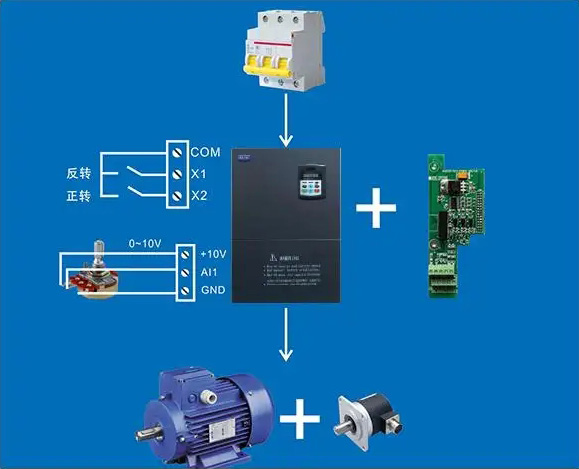Electric motors are familiar to us and can be seen everywhere in life. In daily production and life, motors are basically involved. Frequency converter is a kind of control equipment, which can change the frequency of voltage, and has a good energy-saving effect. Today I want to introduce the relationship between frequency converter and motor.
As you can see from the name, three-phase motors need to use three-phase power. In order to make the motor run smoothly, the power supply room is indispensable. Although the production capacity has increased a lot, there is also a lot of power waste. The motor itself is usually unable to adjust the speed or control the starting voltage, and the power consumption damages the motor. At this time, a device is needed to achieve energy conservation and protection through real-time speed regulation and soft start. It is a frequency converter. In short, the frequency converter is like the remote control of the motor, and this remote control has the advantages of energy saving, protection, simple operation, and strong applicability.
As the name implies, the frequency converter is to change the frequency of the voltage. Usually, the motor is powered by alternating current with constant frequency, which cannot be regulated. Through the frequency converter, it can be changed into alternating current with adjustable frequency and voltage.
The specific process is to install a frequency converter between the power supply and the motor, so that the current will not directly enter the motor. When the current enters the frequency converter, the rectifier module will first turn the incoming AC power into DC power, and then enter the capacitor to adjust the voltage to make it stable. Finally, the inverter will change the DC power back to AC power. The AC power at this time is different from that at the beginning, and it is controllable. At this time, it can be output to the motor. If you want to change the voltage frequency to control the motor speed, you can adjust it when outputting from the inverter.
There is more than a control relationship between the inverter and the motor. With the inverter, the motor works more stably and efficiently, and is safe and energy-saving. Therefore, the inverter also plays a role in promoting the motor.

In the actual application process of the motor, the cooperation with the frequency converter is more and more common. Setting and debugging the parameters of the frequency converter is a fundamental guarantee for the normal operation of the equipment. Many problems that occur on the site are often parameter setting problems, but have nothing to do with the equipment itself. This shows the importance of reasonable and correct parameter setting. Before setting parameters, read the product manual in detail, and pay attention to the following three points:
(1) Setting of basic parameters The basic parameters include the rated power, voltage, current, speed, frequency, starting, braking and motor control methods on the motor nameplate. Here, it should be noted that the input voltage should be selected according to the power supply situation of the unit, and the setting of the maximum output frequency should also be careful;
(2) Set other parameters according to the requirements of the production process. The frequency converter generally has dozens to hundreds of parameters that can be set. In actual application, most of them can be factory set. Only a few special settings can meet the production requirements. If heavy load starting is required, the starting lifting parameters must be set. The torque can be increased by setting two parameters: continuous lifting and starting lifting. The lifting torque is only effective at starting and superposed with the continuous lifting. The sum of the superposition points is limited to less than 250%. When the frequency reaches the set value, the starting lifting function ends, so that the starting requirements of the equipment can be met.
(3) After the initial operation parameters of the equipment are set, when entering the initial operation stage, carefully check the lines to ensure the correctness of the wiring, and check the phase sequence of the equipment that does not allow reversal. To ensure safety and reliability, it is recommended to start slowly with keyboard manual control mode, observe equipment operation and output current, reasonably adjust motor starting and braking time, torque and other parameters, gradually accelerate to rated speed, and put it into automatic mode after normal operation to complete the test run.
Hengda has been engaged in the R&D and manufacturing of variable frequency speed regulation series of three-phase asynchronous motors for many years, among which YE3VP/YE4VP variable frequency speed regulation series of three-phase asynchronous motors are newly developed and developed high-efficiency variable frequency speed regulation motors.
This series of motors adopts superior electromagnetic design scheme, low energy consumption cold-rolled silicon steel plate and high purity anti corona electromagnetic enamelled wire to ensure constant torque output at low speed and certain overload capacity at high frequency. The motor has strong adaptability to over-voltage caused by high-frequency carrier wave of frequency converter due to the adoption of excellent electromagnetic wires and insulating materials, reliable impregnation process and detection measures. This series of motors are cooled by independent fans to ensure that the temperature rise of the motor does not exceed the allowable value during low speed and long-term operation. The motor can be conveniently installed with brake device, encoder and tachometer to achieve rapid braking and automatic control.
YE3VP/YE4VP series variable-frequency adjustable speed motors have the advantages of high efficiency, low noise, small vibration, wide speed range, reliable operation, etc. It is widely used in textile, fan, water pump to regulate flow, machine tool, chemical metallurgy, steel and other industries for constant torque (below fundamental frequency) and constant power (above fundamental frequency) speed regulation, and can meet the needs of paper making, cable, plastic, packaging, elevators, lifting and other special fields.







